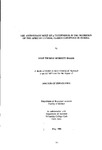THE ANTIOXIDANT ROLE OF α-TOCOPHEROL IN THE NUTRITION
| dc.contributor.author | BAKER, REMI THOMAS MERRETT | |
| dc.contributor.other | School of Biological and Marine Sciences | en_US |
| dc.date.accessioned | 2013-11-07T13:34:59Z | |
| dc.date.available | 2013-11-07T13:34:59Z | |
| dc.date.issued | 1996 | |
| dc.identifier | NOT AVAILABLE | en_US |
| dc.identifier.uri | http://hdl.handle.net/10026.1/2669 | |
| dc.description.abstract |
The role of the lipid-soluble antioxidant α-tocopherol (vitamin E) in the nutrition of African catfish (Clarias gariepinus Burchell) has been investigated with respect to effects on growth, certain indices of health and prevention of tissue lipid peroxidation. Although juvenile C. gariepinus were not found to show an immediate dependency on vitamin E for growth, even during rapid growth stages, a minimum requirement of α-tocopherol based on the prevention of hepatic lipid peroxidation was established at 30-40 mg α-tocopherol per kg dry diet. This is in line with published values for numerous cultured fish species. Tissue α-tocopherol accretion was found to be dependent on dietary dose of the vitamin (supplied as all-rac-α-tocopheryl acetate) and, with the exception of blood-plasma, increased tissue tocopherol status resulted in increased stability against lipid peroxidation. Assessment of iron-ascorbate induced peroxidation (as TBARS) revealed that feeding catfish with diets containing a-tocopherol at several times the currently supplemented level, improved the stability of catfish muscle and this has fillet quality implications. Similarly, heightened fillet vitamin E content resulted in lower moisture exudation from previously frozen fillets, thus demonstrating the role of a-tocopherol in the maintenance of membrane integrity. Oxidation of dietary oils and elevated ingestion of iron were found to be antagonistic of tissue vitamin E concentration. Consumption of feed containing rancid oil had marked effects on tissue fatty acid composition and these effects were modulated by increased intake of α-tocopheryl acetate. In catfish fed diets containing similar amounts of ascorbate, a higher α-tocopherol supplement marginally improved ascorbate retention indicating a possible sparing of vitamin C by vitamin E. The present work will contribute significantly to the understanding of antioxidant nutrition in this poorly researched cultured species. Furthermore, these investigations have improved and strengthened the database of knowledge accumulated within the field of nutrition of finfish. | en_US |
| dc.description.sponsorship | Department of Nutrition, University College Cork, Cork, Eire | en_US |
| dc.language.iso | en | en_US |
| dc.publisher | University of Plymouth | en_US |
| dc.title | THE ANTIOXIDANT ROLE OF α-TOCOPHEROL IN THE NUTRITION | en_US |
| dc.type | Thesis | |
| plymouth.version | Full version | en_US |
| dc.identifier.doi | http://dx.doi.org/10.24382/3323 | |
| dc.identifier.doi | http://dx.doi.org/10.24382/3323 |
Files in this item
This item appears in the following Collection(s)
-
01 Research Theses Main Collection
Research Theses Main


